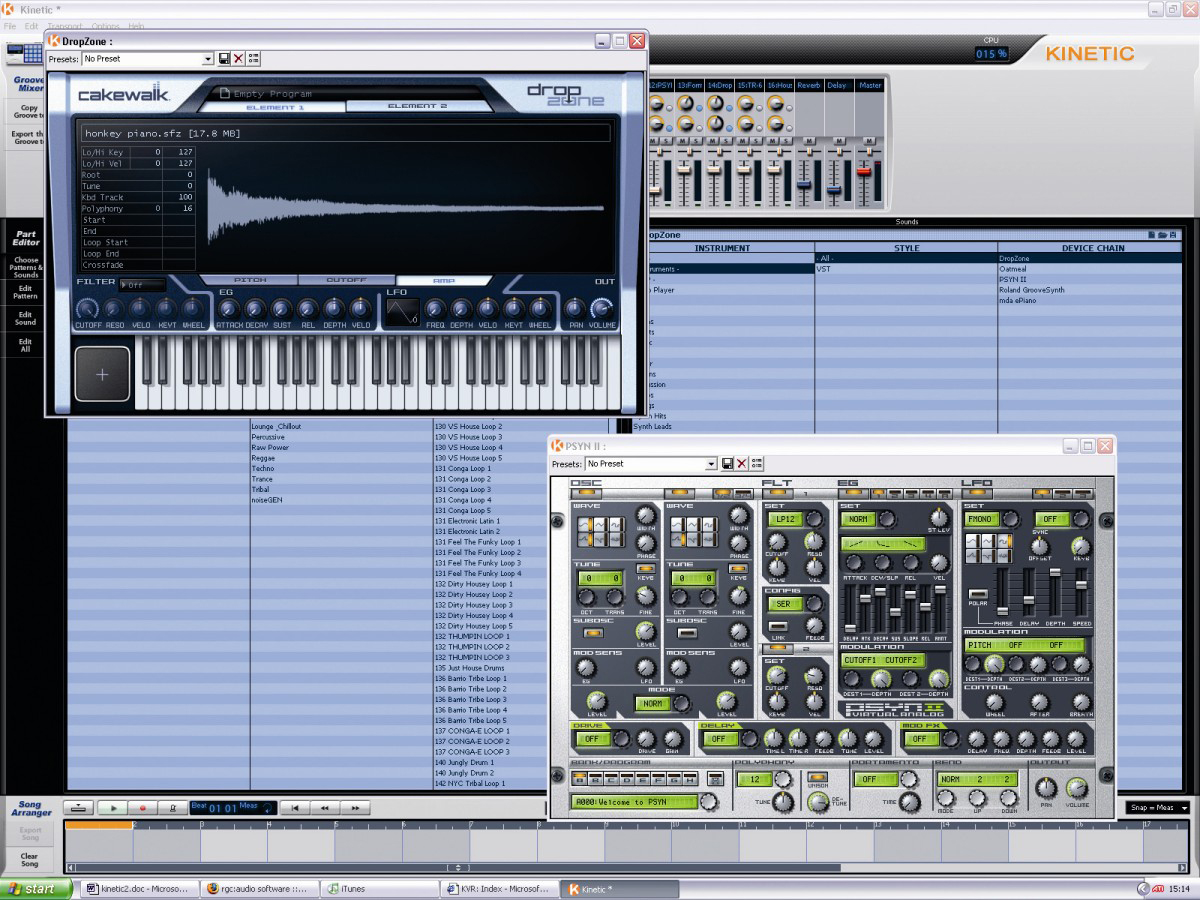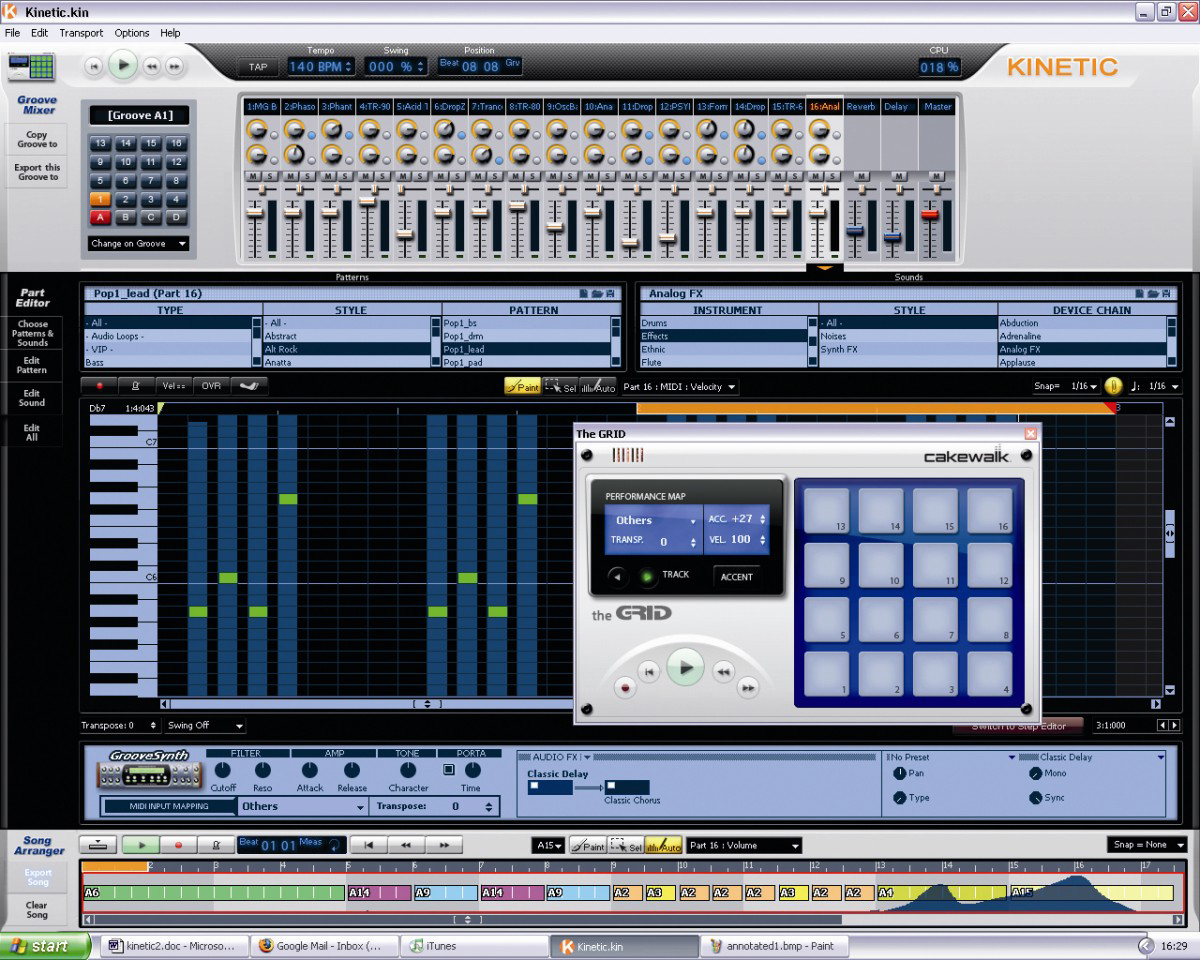MusicRadar Verdict
Kinetic 2 addresses the majority of its predecessor´s shortcomings and adds useful new instruments. Great for beginners and laptop jockeys.
Pros
- +
Extremely easy to use. Wide variety of sounds. At £69, it’s good value.
Cons
- -
Still no MIDI file import.
MusicRadar's got your back


The original version of Kinetic was the first product to have the combined development might of Cakewalk and Roland behind it. Working a little like a software version of one of the latter company´s Grooveboxes, it enabled users to quickly create their own dance music loops by selecting predefined patterns and sounds from menus, then arrange them into complete works via a simple, intuitive sequencer.
The quality of Kinetic's sounds and its ease of use meant it got a fairly warm reception on its release, but there were no send effects and it users were unable to import MIDI. Happily, Kinetic 2 offers new features that are designed to make it more flexible and even easier to use.
Patternss and sounds
Structurally, Kinetic 2 is very similar to its predecessor. To create an individual part, you just pick a pattern and a sound from the browser at the centre of the screen. Patterns (short, editable MIDI sequences) are categorised by type and style - if you want to select a trancey arpeggiator, you choose the ‘Leads´ option in the Type column and ‘Trance´ in the Style column, for example. Kinetic then displays all the preset Trance Lead sequences in the Pattern column.
Once you´ve selected one, you need to assign a sound to play it back. The process for doing this is the same - pick an instrument and style and the appropriate available sounds are displayed in the Device Chain column. Device chains can contain not just instruments but multiple effects, so it´s possible to save out your favourite instrument and effect chains for use in other projects.
Once you´ve selected your pattern and sound, the part plays back and you can either edit it or add another part to play along with the one you´ve just created. Up to 16 parts can be played back simultaneously, and a collection of parts is known as a groove.
It´s possible to create up to 64 different grooves and swap between them using the Groove Picker. Complete tracks can be built either in real time (by selecting which groove you want to play next with the Groove Picker), or in advance by creating a sequence of grooves with the Song Arranger.
Updates
So far, so similar to the original version, but there are plenty of new features in Kinetic 2 that expand its creative potential. The sound generation department has been updated to feature a couple of new instruments, and VST and DirectX plug-in effects and instruments are now supported.
As such, Kinetic´s potential sonic palette has been drastically improved, and it´s now much more useful both in the studio and on stage.
Kinetic´s potential as a performance tool has also been enhanced by the addition of the GRID window, a virtual drum pad that can be operated with your computer´s keyboard. This can be used to trigger both rhythmic and melodic instruments, and features a wealth of what are known as Performance Maps. These are used to modify the GRID´s output and enable you to transpose it, limit it to notes of a certain scale, play pre-defined chord progressions, or even trigger specific slices from a REX loop.
These Performance Maps can also be applied to the MIDI input coming from your MIDI controller, or that of a Roland SP-606. Kinetic 2 offers enhanced compatibility with this hardware, and any grooves you create can automatically be recorded into it as audio parts.
Another useful tweak can be found in the Groove Mixer, which now features those aux sends that were missing last time around. These enable easy application of effects to multiple tracks. Two post-fader send effect chains can be set up and used, and the send level for each part can be automated. In fact, Kinetic 2´s automation facilities are surprisingly comprehensive and include the ability to automate the parameters of plug-ins, including those of VST and DX instruments and effects.
Improved
Kinetic 2 certainly represents a substantial improvement over its predecessor, not least because of the enhanced instruments and plug-in support. These new features - combined with the ability to save out instruments with effect chains and ReWire compatibility - mean that it´s possible to use it as a handy tool for triggering your favourite instrument and effect setups from a host sequencer.
The £69 asking price isn´t too bad when you consider the quality of the various sound modules on offer, though it seems that only the DropZone sampler can be used as a VST instrument outside of Kinetic. To use the PSYN II and GrooveSynth modules externally, you have to ReWire Kinetic and use it to host them rather than your main DAW.
The bottom line, though, is that as a standalone and easy-to-use production tool, Kinetic performs very well.
MusicRadar is the number 1 website for music makers of all kinds, be they guitarists, drummers, keyboard players, djs or producers...
GEAR: We help musicians find the best gear with top-ranking gear round-ups and high- quality, authoritative reviews by a wide team of highly experienced experts.
TIPS: We also provide tuition, from bite-sized tips to advanced work-outs and guidance from recognised musicians and stars.
STARS: We talk to musicians and stars about their creative processes, and the nuts and bolts of their gear and technique. We give fans an insight into the actual craft of music making that no other music website can.
“Built from the same sacred stash of NOS silicon transistors and germanium diodes, giving it the soul – and snarl – of the original”: An octave-fuzz cult classic returns as Jam Pedals resurrects the Octaurus
What’s the buzz? Meet Yellowjacket, Cherry Audio's recreation of EDP’s trend-setting Wasp from 1978
“A fabulous trip through all eight songs by 24 wonderful artists and remixers... way beyond anything I could have hoped for”: Robert Smith announces new Cure remix album










